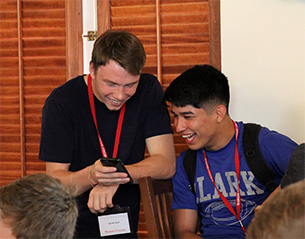With a history of providing opportunities to “diamonds in the rough,” Wabash College has set its sights squarely on improving the retention and graduation rates of first-generation and traditionally under-represented populations with the Wabash Liberal Arts Immersion Program (WLAIP).
“This is a program that acknowledges that students come here at different paces with different experiences in navigating the college process,” said Psychology Professor and Director of WLAIP Robert Horton. “We’re trying to meet these students where they are so that we can do our best by them.”
On the heels of the nationally influential Wabash National Study, the College became aware of data indicating that students of color were reporting a less favorable experience and were graduating at rates unsatisfying to Wabash. The conversations that emerged – in addition to data extrapolated nationally – revealed the issues centered less around race and more on disparities in academic capital among this group of students.
“Anyone who comes to college with limited capital is going to have a difficult time in the transition,” said Horton. “As such, the WLAIP seeks to provide such capital to students who, historically, have had less of it: students of color, first-generation students, and lower-income students.”
 To that end, the WLAIP has six faculty members and seven current students embarking on a vigorous and engaging program, which started July 6, that includes supports designed to point these young men toward success: a four-week pre-enrollment residential program where students enroll in a for-credit English composition course and explore humanities-focused modules from across the liberal arts, a two-day workshop designed for the families of these students to build their knowledge of the Wabash experience, on-going academic and social support throughout the first year, and a summer internship experience prior to the students’ sophomore year.
To that end, the WLAIP has six faculty members and seven current students embarking on a vigorous and engaging program, which started July 6, that includes supports designed to point these young men toward success: a four-week pre-enrollment residential program where students enroll in a for-credit English composition course and explore humanities-focused modules from across the liberal arts, a two-day workshop designed for the families of these students to build their knowledge of the Wabash experience, on-going academic and social support throughout the first year, and a summer internship experience prior to the students’ sophomore year.
While summer bridge programs are common nationally — typically offering under-represented students the opportunity to earn credit in either a math or English course and building college study skills before the first semester— what makes WLAIP stand out is the parental involvement, the opportunities it provides students to broaden their understanding of the humanities, and the pre-sophomore year summer internship.
The two days of WLAIP programming for parents will feature special sessions with Wabash faculty and staff about the value of a liberal arts education, the transition to college, available on-campus counseling and support programs, and the financial ins-and-outs of college attendance.
Current research has shown that the level of connectedness underrepresented students have with their families and community support may aid in academic success and retention. Therefore, finding ways to leverage parental involvement and create a supportive community to enhance the student experience, rather than pushing parents aside, is where the WLAIP can become a model for other campuses.
This program doesn’t simply plug underserved populations into resources, but intends to remove potential blinders to what they believe the college experience should be. It opens a wide-ranging expanse of possibilities, so that a student might think, ‘I don’t have to come here and be a doctor, lawyer, or teacher. I can do anything that might interest me.’
One key to the WLAIP is nimbleness. With an enrollment just north of 900 men, Wabash has the ability to put its resources squarely behind its educational mission.
“While there are challenges to being a narrowly-gauged institution, one advantage we ought to have is to be able to customize, focus and find success,” said Dean of the College Scott Feller. “If we can’t come up with customized solutions to meet these barriers, perhaps no one can. We are here to provide an off-the-beaten-path educational experience that brings success to all young men.”
Rather than simply increase selectivity, Feller wants to increase graduation rates without sacrificing educational mission, as the College has prided itself on providing opportunity to men of modest socio-economic means. Inclusivity matters at Wabash.
“We could achieve a modest increase in graduation rate simply by measures of increasing selectivity alone,” he said. “I want to see us be as effective with this population rather than to change the type of institution that we are.”
All with one goal in mind.
“We want for these students what we want for all students – an engaging, supportive, successful career – and we think the WLAIP will make them more aware of how that can happen,” said Horton.